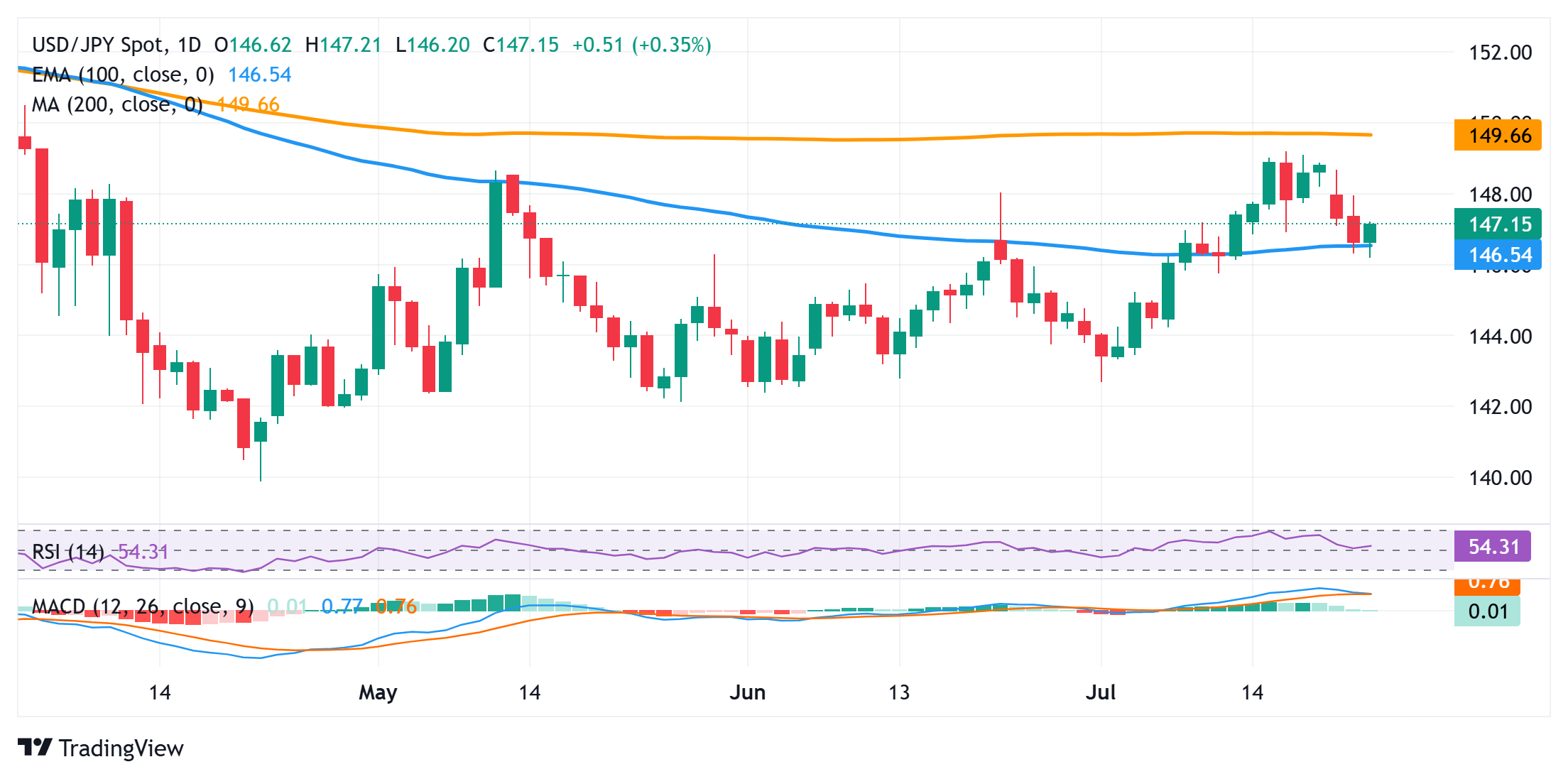The Japanese Yen gets a minor lift after Trump announced US-Japan trade deal.
Domestic political uncertainty prompts heavy intraday selling around the JPY.
A modest USD bounce from a two-week low further supports the USD/JPY pair.
The Japanese Yen (JPY) retreats sharply from a two-week top set against a broadly rebounding US Dollar (USD) in reaction to reports that Japan’s Prime Minister Shigeru Ishiba will resign by the end of August. This adds a layer of political uncertainty, which, along with the upbeat market mood, turns out to be a key factor undermining the safe-haven JPY.
Meanwhile, US President Donald Trump announced a massive trade deal with Japan ahead of the impending August 1 tariffs deadline. This might hold back the JPY bears from placing aggressive bets. Furthermore, the uncertainty over the Federal Reserve’s (Fed) rate cut path could keep a lid on any further appreciation for the USD and the USD/JPY pair.
Japanese Yen bears retain intraday control amid political uncertainty in Japan
In a social media post, US President Donald Trump announced that his administration had completed a trade deal with Japan. Trump added that Japan will be subject to reciprocal tariffs of 15% and will open their country to trade, including cars and trucks, rice, and certain other agricultural products.
This helps ease market concerns about the potential economic fallout from steep US tariffs and pushes the Japanese Yen higher against the US Dollar for the third straight day, to a nearly two-week top during the Asian session on Wednesday. However, domestic political uncertainty caps the JPY gains.
Japan’s ruling coalition – the Liberal Democratic Party (LDP) and its junior partner Komeito – failed to secure a majority in the upper house election on Sunday. Having already lost its majority in Japan’s more powerful lower house last year, the outcome is expected to undermine the coalition’s influence.
History suggests that domestic political uncertainty tends to keep the Bank of Japan on the sidelines, suggesting that prospects for rate hikes could be delayed for a little bit longer, at least until October. This warrants caution for the JPY bulls and supports the USD/JPY pair amid a modest USD uptick.
BoJ Deputy Governor Shinichi Uchida reiterated that the central bank will continue to raise its policy rate if the economy and prices move in line with its projections. Core consumer inflation may briefly dip below 2% the next fiscal year but is expected to gradually re-accelerate thereafter, Uchida added.
Traders now look forward to the release of the US Existing Home Sales data, due later during the North American session. The focus, however, remains on the flash global PMIs on Thursday, which would provide a fresh insight into the global economic health and influence demand for the safe-haven JPY.
USD/JPY looks to build on goodish intraday bounce from the 100-day SMA

The USD/JPY pair now seems to have found acceptance below the 38.2% Fibonacci retracement level of the monthly upswing. However, spot prices have been showing some resilience below the 100-day Simple Moving Average (SMA). This, in turn, warrants some caution for bearish traders amid neutral oscillators on the daily chart. Hence, any further slide is more likely to attract some buyers and remain cushioned near the 146.00-145.90 region, or the 50% retracement level. Some follow-through selling, however, should pave the way for deeper losses towards the 145.00 psychological mark.
On the flip side, some follow-through buying could lift the USD/JPY pair further towards the 147.65 hurdle en route to the 148.00 round figure. A sustained strength beyond the latter would negate any near-term negative outlook and lift spot prices to the 149.00 mark with some intermediate hurdle near the 148.65 region, or the weekly high.
Bank of Japan FAQs
The Bank of Japan (BoJ) is the Japanese central bank, which sets monetary policy in the country. Its mandate is to issue banknotes and carry out currency and monetary control to ensure price stability, which means an inflation target of around 2%.
The Bank of Japan embarked in an ultra-loose monetary policy in 2013 in order to stimulate the economy and fuel inflation amid a low-inflationary environment. The bank’s policy is based on Quantitative and Qualitative Easing (QQE), or printing notes to buy assets such as government or corporate bonds to provide liquidity. In 2016, the bank doubled down on its strategy and further loosened policy by first introducing negative interest rates and then directly controlling the yield of its 10-year government bonds. In March 2024, the BoJ lifted interest rates, effectively retreating from the ultra-loose monetary policy stance.
The Bank’s massive stimulus caused the Yen to depreciate against its main currency peers. This process exacerbated in 2022 and 2023 due to an increasing policy divergence between the Bank of Japan and other main central banks, which opted to increase interest rates sharply to fight decades-high levels of inflation. The BoJ’s policy led to a widening differential with other currencies, dragging down the value of the Yen. This trend partly reversed in 2024, when the BoJ decided to abandon its ultra-loose policy stance.
A weaker Yen and the spike in global energy prices led to an increase in Japanese inflation, which exceeded the BoJ’s 2% target. The prospect of rising salaries in the country – a key element fuelling inflation – also contributed to the move.


AloJapan.com